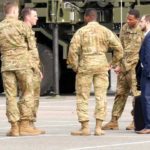Eric Geoffroy, Director UTC Aerospace, told us more about tools to tackle the growing laser threat.
The increased use and availability of laser-aided weapons presents new challenges in defence.
Eric Geoffroy, Director, Threat Detection Systems, UTC Aerospace, told us more about tools to tackle this.
The AN/AVR 2B Laser Warning System, for example, is in service on Apaches, Black Hawks and Chinooks. Over 2,000 of these systems have already been delivered to the US Army.
He said: “A lot of these systems have seen multiple combat tours. They detect range finders, target designators and beam riders efficiently.
“Since the emerging threat seems to be very pervasive, the timing is right now to outfit our NATO partners with this type of technology.”
Geoffroy explains: “A lot of these lasers are invisible and you don’t know they’re hitting you…until it’s possibly too late. Our system provides you with that advanced warning, giving you precious seconds to act.”
Gamechanger: Threats on the ground
UTC Aerospace has also adapted the technology for threats on the ground. It is currently working with the US Army on integrating its new VVR-4.
According to Geoffroy: “It is a gamechanger when you look at the ground fleets and how we are facing emerging near-peer threats. In the past, with air superiority we have not really had the need for laser warning survivability equipment on ground vehicles.”
Now with the advent of emerging threats and cheaper weapons, laser warning is essential in the air and on the ground, he said.
A modular approach
A further development is the VVR-4M, which introduces a modular approach so that it can be rapidly adapted to meet new threats as they appear. This can include software updates or the introduction of new sensor elements. The modularity also allows the VVR-4M to be reconfigured to meet mission-specific requirements.

